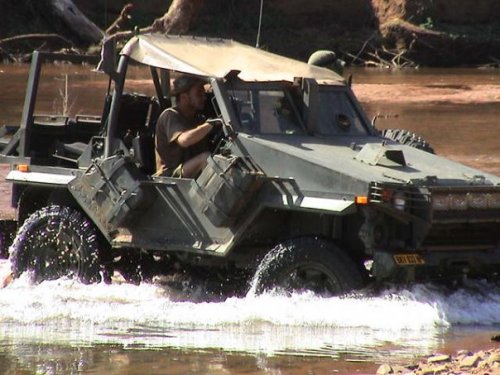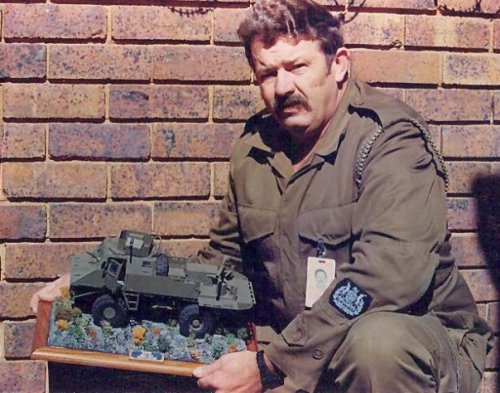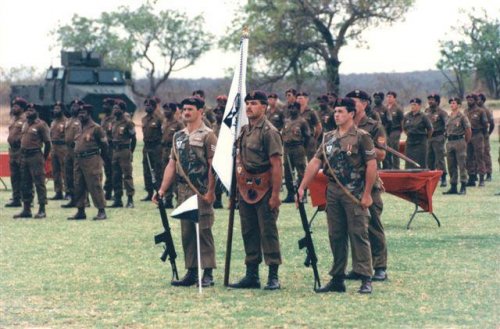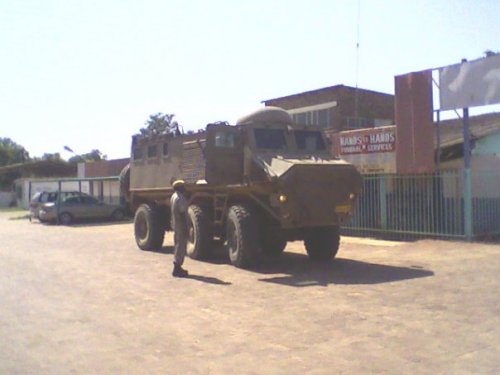- Joined
- 27 March 2006
- Messages
- 1,870
- Reaction score
- 1,617
Have been reading up about Dr Vernon Joynt. Quite fascinating. He has had a massive influence on mine proof/MRAP vehicles, as well as a host of other military devices.
kaiserbill said:That is a composite Photo Shop (poorly done) as far as I know.
kaiserbill said:Hi Xiaofan
Got anything interesting on your computer about South African projects? I've noticed you have posted excellent material on other threads.
curious george said:Found this pic on a blog, or f/book.If I stumble across it again I'll quiz the owner/poster.
I guess this to be at some undisclosed forward base in either Angola,or the then-SWA(Namibia).Maybe +/- '83 Ops Askari(?)or maybe later,captured FAPLA T's in the forground...
check out left of the T's:
MAN 8 x 8 vehicle(facing) right,with spare just behind cab(obscured by tree)??
curious george said:Interesting to see that they were even in their original dark green north west Europe colouring. West Germany provided quite a bit of covert and semi-pvert support to South Africa even after the UN mandatory embargo.
I can confirm that the one I saw in late '87 at my base was the dark green.
Off topic:Incidently so were(colour) the merc 4 x 4 trucks & the odd Gelandewagen.(CSI-add old army browns and "written off" l/rovers,etc) used by CSI(read Unita) for logistics on our side off the border,that also visited the main log base at Rundu.Another aspect that tickles me still:how were the 107mm mrl's(used by recce's & unita) "sourced".Dont think they were used that widely by angolans(?),and Unita were buddy-buddy with the Chinese at one stage)
curious george said:Another aspect that tickles me still:how were the 107mm mrl's(used by recce's & unita) "sourced".
kaiserbill said:curious george said:Another aspect that tickles me still:how were the 107mm mrl's(used by recce's & unita) "sourced".
South Africa made a copy of the Chinese 107mm mrl. It was known as the Mechem RO107. Interestingly, they also made a single tube light launcher for use by special forces, probably for use against targets such as airfields.
xiaofan said:In China we call the 107mm mrl's just 107, it is one of three must have things for guerrilla or insurgency forces (other two are the RPG and AK, and just like the RPG and AK, the 107 do showed up in hot sopts), there are a lot of 107 circulating around. Some of them brand new come form China or other countries (there are a few countries build 107 on their own), some are second hand, some of them were been captured on the battlefield. Soviet captured some 107 in Afghanistan and so was Americans in Vietnam, both Soviet and American may have supply these 107 to the friendly forces.
The one I saw at Lohatla in 90 was also in the drab west german army green, stood out like tits on a bull amongst the brown tiffy trucksxiaofan said:curious george said:Interesting to see that they were even in their original dark green north west Europe colouring. West Germany provided quite a bit of covert and semi-pvert support to South Africa even after the UN mandatory embargo.
I can confirm that the one I saw in late '87 at my base was the dark green.
royabulgaf said:
A fellow forumite sent it to me, so it's his find. It also shows that there is obviously info out there, which just needs gentle prising out.sealordlawrence said:Kaiser,
That is an awesome find, thanks just for posting, it looks like it probably explains the whole Hoefyster programme- I would really appreciate a translation if possible.
The Replacement of a Legend – Project Hoefyster
Follow-on to the Ratel 6X6 Infantry Fighting Vehicle
A preliminary investigation/research(?) to the acquiring of an Infantry Fighting Vehicle (IFV) by the then SADF, was formulated in 1970, and was followed by a users requirement in March 1971. A number of prototypes were evaluated from the period of January 1972 until October 1972, which included the following:
Unimog 4X4 UR416 (West Germany), code named BOGGEBEES.
Panhard 4X4 M3 (France), code named BOSBOK
Panhard 4X4 M3 (France), code named ONSBOK (Successor/follow on of the BOSBOK)
Panhard 4X4 M4 (France), code named KLONKIE
Berliet 4X4 VXB, (France), code named BOESMAN
MAN Bussing 6X6 (West Germany), code named BUFFEL
Engesa 6X6 from Brazil
The Technical Service Corp of the SADF also developed a vehicle called the SPRINGKAAN, which also took part in these trials.
Most of these vehicles are on display at 1 South African Infantry Battalion (the BUFFEL at the front gate on the right), or at the Tank Museum at the School of Armour.
The BUFFEL, which was accommodated(?) by MAN of west Germany, was manufactured in South Africa by Springfield Bussing, and was found to be the most suitable vehicle, measured by the users requirement. The vehicle was then further developed into the Ratel, which was first seen in public in 1976. More than 1200 of these highly reliable – and much loved – vehicles were manufactured and is still to this day in service with the South African Army. Vehicles were also exported to Morocco and Jordan, as well as other countries in Africa.
Time, and the ongoing development of warfare, has eventually started to catch up with the Ratel, and it became obvious that a replacement should start to be looked at. Some of the new requirements were:
Troops must deploy from behind the vehicle.
Improved ballistic protection.
Improved mine protection.
Improved internal space.
Improved firepower
Improved mobility to be able to keep pace with the then new generation tank and armoured car.
Also, spare parts and components, particularly the drivetrain (engine and gearbox) were starting to become difficult due to the age of some of the components, due to much lighter and smaller engines and gearboxes available on the market.
Project HOEFYSTER was registered in the late 1990’sby the SANDF to fullfill the new requirements. This was issued out to and answered by the various South African Defence Industry companies. Armscor granted contracts in 2002 to 4 of these South African companies. These contracts covered the development stage, and manufacturing of a full scale steel model, of a concept that must meet all the requirements of Project HOEFYSTER. The following companies participated in this stage:
Industrial Automotive Design SA (IADSA)
Land Mobility Technologies (LMT)
Mechanology Design Bureau (MDB)
Vickers OMC (Olifant Manufacturing Company) – now known as BAE Land Systems OMC.
LIW (Lyttleton Ingenieur Werk), now Denel Land Systems, was at the same time contracted by Armscor to develop the turret for these vehicles, equipped with a 30mm or 35mm gun. The full-scale vehicle models are on display at 1 South African Infantry Battalion (1SAI) and are presented in different configurations.( The OMC and LMT models are equipped with turrets developed by Denel following a contract with Armscor.)
LMT’s concept (middle, figure 1) scored the most points during the Armscor evaluation. An international request for examples for the purchase of 264 HOEFYSTER vehicles was then issued by Armscor. This vehicle would come in 5 different variations and would equip 3 mechanised infantry battalions of the South African Army. For various reasons, only one vehicle supplier, Patria Vehicles of Finland, reacted to this next request, with the AMV 8X8 vehicle.
(This next bit I’m struggling with)
This supplier ensured the silence of Denel (head contractor and turret provider), LMT (engineering, including mine-proofing, ILS, and special manufacturing), and BAE Land Systems OMC (hull manufacturing, integration, and field support.) The flat bottomed anti- mine protection system which was developed under contract from Patria by LMT, is manufactured by Patria’s subsidiaries in Finland for the Finnish army.
Patria Vehicles is part of the Patria Group, and was successful with winning of contracts for the 8X8 AMV vehicle in Poland (690 vehicles) and Slovenia (minimum 200 vehicles). This vehicle is the only 4th generation vehicle of it’s sort which is in production and has (uithaler?) mobility and protection. A range of different weapon stations - or turrets – can be carried, depending on the chosen variant. The specifications of this vehicle is as follows:
Length 7,7m
Height over hull 2.3m
Width 2,8m
Track width 2,5m
Fighting weight 26 000kg
Max speed over 100km/h
Vertical slope 60%
Voor oorsteking (trench?) above 2m
Diepte gang (?) 1500mm
Fighting Range 800km
Engine 360kW
Gearbox Automatic 7 forward, 1 reverse
Suspension Independent double wishbone with hydropneumatic stops (adjustable height)
Crew driver, vehicle commander, section commander (in turret), gunner (in turret) and 7 section members in the back.
Characteristics:
150 liters of water that is chilled to 16c for crew use
Unique back door and ramp combination for storage of platoon weapons
Airconditioner and chemical biological unit that keeps air clean by filtering it during chemical/biological attack.
Flat hulled mineproof protection system
Unique equipment storage provision for every individual member
High ballistic protection
Vehicle is completely amphibious when it weighs less than 22 000kg at a speed of 10km/h.
The first vehicle, known as E1, was in 2004, and was tested at various locations successfully.
If anyone has a better idea on extracting the pictures in the PDF's below so as to post them in a better viewable manner, please feel free to do so.
Thanks for the link. Besides the Unimogs, what else did they use? Land Rovers or Land Cruisers? With all the mods it's difficult to identify the base vehicle.curious george said:https://www.facebook.com/media/set/?set=oa.10150579901205797&type=1
While not necessarily prototypes per se,these "esoteric" vehicles were very few and far between and belonged to the 44 para brig "pathfinder company".Maybe someone can kindly post pics or supply a link to similarly modified vehicles used by the "recce's".(A 5 Recce commando stayed over in our base once,vehicle's incl mog's with 106's rc/14.5mm x 2 kpv,or 23mm x 2,not sure as they were covered,casspirs and kwevoel log vehicles.That was '86/7,so memory a bit hazy.)
CostasTT said:curious george said:https://www.facebook.com/media/set/?set=oa.10150579901205797&type=1
Thanks for the link. Besides the Unimogs, what else did they use? Land Rovers or Land Cruisers? With all the mods it's difficult to identify the base vehicle.
Hi Costas,according to Graham Gilmore's book,"Pathfinder Company:the Philistines", they rebuilt/modified both types.






















